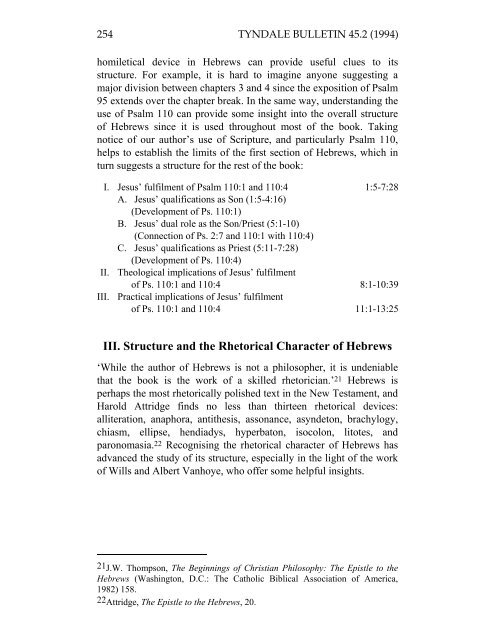the structure of hebrews from three perspectives - Tyndale House
the structure of hebrews from three perspectives - Tyndale House
the structure of hebrews from three perspectives - Tyndale House
Create successful ePaper yourself
Turn your PDF publications into a flip-book with our unique Google optimized e-Paper software.
254 TYNDALE BULLETIN 45.2 (1994)<br />
homiletical device in Hebrews can provide useful clues to its<br />
<strong>structure</strong>. For example, it is hard to imagine anyone suggesting a<br />
major division between chapters 3 and 4 since <strong>the</strong> exposition <strong>of</strong> Psalm<br />
95 extends over <strong>the</strong> chapter break. In <strong>the</strong> same way, understanding <strong>the</strong><br />
use <strong>of</strong> Psalm 110 can provide some insight into <strong>the</strong> overall <strong>structure</strong><br />
<strong>of</strong> Hebrews since it is used throughout most <strong>of</strong> <strong>the</strong> book. Taking<br />
notice <strong>of</strong> our author’s use <strong>of</strong> Scripture, and particularly Psalm 110,<br />
helps to establish <strong>the</strong> limits <strong>of</strong> <strong>the</strong> first section <strong>of</strong> Hebrews, which in<br />
turn suggests a <strong>structure</strong> for <strong>the</strong> rest <strong>of</strong> <strong>the</strong> book:<br />
I. Jesus’ fulfilment <strong>of</strong> Psalm 110:1 and 110:4 1:5-7:28<br />
A. Jesus’ qualifications as Son (1:5-4:16)<br />
(Development <strong>of</strong> Ps. 110:1)<br />
B. Jesus’ dual role as <strong>the</strong> Son/Priest (5:1-10)<br />
(Connection <strong>of</strong> Ps. 2:7 and 110:1 with 110:4)<br />
C. Jesus’ qualifications as Priest (5:11-7:28)<br />
(Development <strong>of</strong> Ps. 110:4)<br />
II. Theological implications <strong>of</strong> Jesus’ fulfilment<br />
<strong>of</strong> Ps. 110:1 and 110:4 8:1-10:39<br />
III. Practical implications <strong>of</strong> Jesus’ fulfilment<br />
<strong>of</strong> Ps. 110:1 and 110:4 11:1-13:25<br />
III. Structure and <strong>the</strong> Rhetorical Character <strong>of</strong> Hebrews<br />
‘While <strong>the</strong> author <strong>of</strong> Hebrews is not a philosopher, it is undeniable<br />
that <strong>the</strong> book is <strong>the</strong> work <strong>of</strong> a skilled rhetorician.’ 21 Hebrews is<br />
perhaps <strong>the</strong> most rhetorically polished text in <strong>the</strong> New Testament, and<br />
Harold Attridge finds no less than thirteen rhetorical devices:<br />
alliteration, anaphora, anti<strong>the</strong>sis, assonance, asyndeton, brachylogy,<br />
chiasm, ellipse, hendiadys, hyperbaton, isocolon, litotes, and<br />
paronomasia. 22 Recognising <strong>the</strong> rhetorical character <strong>of</strong> Hebrews has<br />
advanced <strong>the</strong> study <strong>of</strong> its <strong>structure</strong>, especially in <strong>the</strong> light <strong>of</strong> <strong>the</strong> work<br />
<strong>of</strong> Wills and Albert Vanhoye, who <strong>of</strong>fer some helpful insights.<br />
21J.W. Thompson, The Beginnings <strong>of</strong> Christian Philosophy: The Epistle to <strong>the</strong><br />
Hebrews (Washington, D.C.: The Catholic Biblical Association <strong>of</strong> America,<br />
1982) 158.<br />
22Attridge, The Epistle to <strong>the</strong> Hebrews, 20.
















